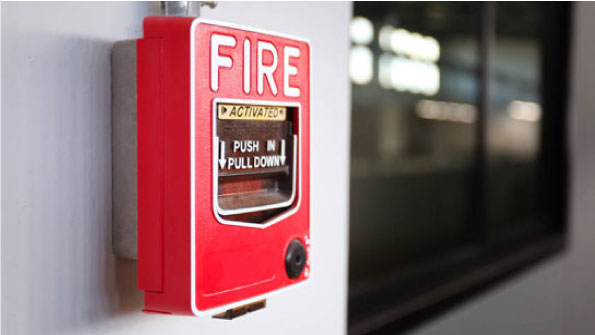
|
Fire Alarm System
Fire Alarm Systems are critical for detecting and alerting occupants to the presence of fire, smoke, or other hazardous conditions, ensuring swift evacuation and response. At ZM International, we provide comprehensive fire alarm solutions tailored to different environments, ranging from small residential setups to large commercial or industrial facilities. Our fire alarm systems comply with both international (NFPA) and local (BNBC) standards to ensure optimal safety.
1. Types of Fire Alarm Systems:
We offer two main types of fire alarm systems based on the complexity and size of the building or facility:
1.1. Conventional Fire Alarm Systems:
Zoned Systems: Each area of the building is divided into different zones, with detectors in each zone connected to the control panel. When an alarm is triggered, the panel indicates the zone where the fire or smoke has been detected, though it does not specify the exact detector.
Ideal for small to medium-sized buildings such as schools, small offices, or retail stores.
Components:
Smoke, heat, or flame detectors for each zone.
Manual call points (break glass units) for activating alarms.
Sounders and strobes for audio-visual alarms.
Control panel to monitor and display the alarm’s zone.
1.2. Addressable Fire Alarm Systems:
Individual Device Monitoring: Each detector, call point, and sounder has its own unique address, which means the control panel can identify exactly where the fire or fault has occurred. This allows for quicker response times and more precise fire management.
Highly scalable, making it suitable for larger buildings like hospitals, hotels, commercial complexes, and industrial facilities.
Components:
Addressable smoke, heat, or flame detectors.
Addressable manual call points.
Addressable sounders and strobes.
Addressable control panel with advanced monitoring capabilities.
2. Detection Technologies:
We offer a variety of fire detection technologies to suit different environments and fire risks:
2.1. Smoke Detectors:
Ionization Smoke Detectors: Detect fast-flaming fires by sensing small smoke particles generated from flames. Ideal for areas where fast, hot fires might occur.
Photoelectric Smoke Detectors: Use light sensors to detect larger smoke particles produced by smoldering fires, making them suitable for environments where slow-burning fires may develop, like living spaces or offices.
2.2. Heat Detectors:
Fixed Temperature Heat Detectors: Trigger an alarm when the temperature exceeds a predefined level, often used in areas where smoke detectors are unsuitable, such as kitchens or boiler rooms.
Rate-of-Rise Heat Detectors: Detect rapid increases in temperature, ideal for areas where temperature fluctuations are a potential sign of fire.
2.3. Flame Detectors:
Use ultraviolet (UV) or infrared (IR) technology to detect open flames, making them ideal for high-risk industrial environments such as oil refineries, chemical plants, or areas where flammable liquids are present.
2.4. Multi-Sensor Detectors:
Combine smoke, heat, and carbon monoxide (CO) detection for more comprehensive fire detection. These detectors are highly reliable and reduce the likelihood of false alarms.
3. Alarm Devices:
Our systems are equipped with various alarm devices to ensure that building occupants are alerted in the event of a fire:
3.1. Sounders & Sirens:
Emit loud, continuous alarms to warn occupants of a fire or emergency situation.
Available in different sound levels to suit various environments.
3.2. Strobes & Flashing Lights:
Provide visual alarms, especially useful in noisy environments like factories or for individuals with hearing impairments.
Common in places like hospitals, auditoriums, and public areas.
3.3. Voice Evacuation Systems:
Broadcast clear, pre-recorded voice instructions in the event of an emergency to guide occupants on how to evacuate safely.
Particularly useful for large buildings with multiple exits or in high-traffic areas like airports and shopping malls.
4. Control Panels:
The control panel is the heart of any fire alarm system, and we offer a range of advanced options:
4.1. Conventional Control Panels:
Simple panels that display which zone has been triggered, requiring manual inspection of the area to locate the specific issue.
4.2. Addressable Control Panels:
Advanced control panels that pinpoint the exact location of the triggered detector, providing more detailed information for faster and more effective fire management.
4.3. Networked Fire Alarm Systems:
Allow multiple control panels to be linked across large sites, providing centralized control of fire detection and alarm systems in complex environments like industrial plants, campuses, or multi-building facilities.
5. Specialized Fire Alarm Systems:
For environments with unique fire safety challenges, we provide specialized systems:
5.1. Wireless Fire Alarm Systems:
Ideal for buildings where wiring is impractical, such as heritage sites, temporary structures, or buildings undergoing renovation.
Easy to install and reconfigure, offering flexibility and mobility.
5.2. Aspirating Smoke Detection Systems (ASD):
Highly sensitive systems that continuously sample air to detect smoke at an early stage, even before visible smoke is present.
Commonly used in high-risk environments such as data centers, server rooms, museums, and clean rooms.
5.3. Explosion-Proof Fire Alarm Systems:
Designed for hazardous environments like oil and gas facilities or chemical plants, where explosions or fires could occur in the presence of volatile gases or chemicals.
6. Fire Alarm Integration:
We can integrate fire alarm systems with other building safety and security systems for a comprehensive solution:
6.1. Fire Alarm & Sprinkler System Integration:
When a fire is detected, the system can automatically activate sprinklers in the affected area to control or extinguish the fire.
6.2. Fire Alarm & Access Control Integration:
In case of fire, the access control system can automatically unlock doors or gates to ensure smooth evacuation.
6.3. Fire Alarm & Elevator Control:
Elevators can be automatically recalled to the ground floor and disabled during a fire to prevent occupants from using them.
6.4. Integration with Building Management Systems (BMS):
Allows centralized monitoring and control of fire alarms alongside other building systems such as HVAC, lighting, and security.
7. Emergency Power Backup:
All our fire alarm systems are equipped with battery backup systems to ensure functionality during power outages, providing continuous protection in all situations.
At ZM International, we design and install fire alarm systems customized to meet the specific fire safety requirements of your building, ensuring compliance with local and international standards. Whether you need a simple conventional system or a fully networked, addressable system, our solutions are built to provide rapid detection, reliable alerts, and seamless integration with other safety systems.
|























